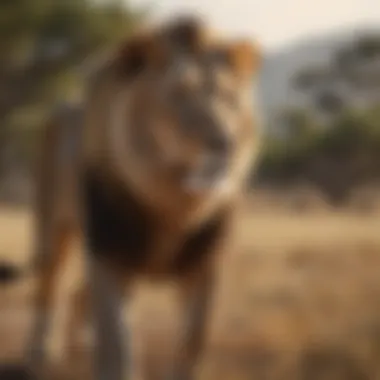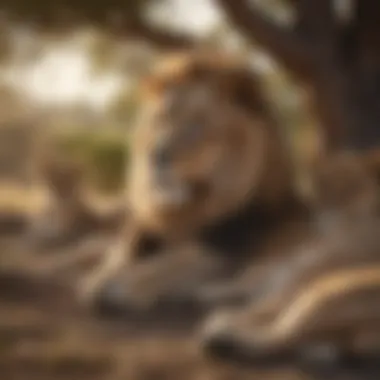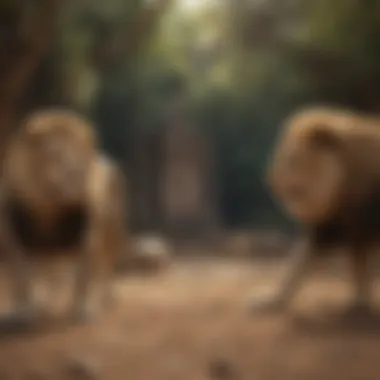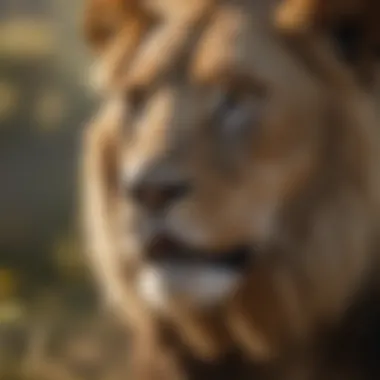The Lion's Role in Ecosystem and Cultural Significance


Intro
Lions have long captivated the human imagination. Their powerful presence in both the wild and in culture highlights their importance. This article delves into various aspects of lions, focusing on their ecological significance and cultural relevance. Understanding these facets is essential for informing conservation efforts and appreciating lions' roles within the animal kingdom and human history.
Animal Overview
Common Name and Scientific Classification
The common name is the lion, with the scientific name being Panthera leo. This species belongs to the family Felidae and is categorized as a large wild cat. Lions primarily inhabit the African savanna, but a small population also exists in the Gir Forest of India.
Physical Characteristics
Lions are notable for their distinctive features. Males are generally larger than females and possess a mane, which varies in color and size. This mane serves not only as a display of strength but also as protection during fights. Adult males typically weigh between 330 to 550 pounds, while females weigh between 265 to 400 pounds. Their coats range from light tawny to dark brown, aiding in camouflage.
Habitat and Distribution
Lions prefer open woodlands and grasslands. These areas provide both cover for stalking prey and ample hunting grounds. Their distribution has dramatically decreased over the years due to habitat loss. Today, wild lions can primarily be found in sub-Saharan Africa, with a small population in India.
Behavior and Social Structure
Communication Methods
Lions communicate through various methods. Vocalizations include roars, growls, and grunts, each serving different purposes. A lion's roar can travel long distances and is often used to assert territory. Body language, such as tail positioning and facial expressions, also plays a significant role in their communication.
Social Hierarchies
Lions exhibit a complex social structure known as a pride. A pride typically consists of several related females, their offspring, and a few males. The females do most of the hunting and rearing of young, while males defend the pride's territory. Dominance hierarchies among males influence mating opportunities and pride stability.
Mating and Reproductive Behavior
Breeding occurs year-round, but peaks during certain seasons. After a gestation period of around 110 days, females give birth to one to four cubs. Cubs are dependent on their mothers for food and protection. Social dynamics within the pride influence cub survival and development.
Conservation Status
Current Population Trends
Lion populations have drastically declined in recent decades. Current estimates suggest that there are about 20,000 lions left in the wild. This significant drop raises alarms among conservationists.
Threats and Challenges
Several factors threaten lion populations. Habitat loss due to human encroachment is the most critical challenge. Additionally, hunting and poaching further diminish their numbers. Conflicts with humans arise when lions prey on livestock, leading to retaliatory killings.
Conservation Efforts and Success Stories
Numerous organizations and government initiatives work towards lion conservation. These efforts involve habitat protection, community engagement, and anti-poaching campaigns. Some success stories include well-managed reserves in Tanzania and a resurgence of the Gir Forest population in India. Continued advocacy and awareness are crucial for future lion preservation.
The future of lions hinges on our commitment to their conservation and understanding their ecological importance.
Prelude to Lions


Lions hold a unique position within both their natural ecosystem and various human cultures. Understanding lions is essential for wildlife management, biological study, and conservation efforts. The significance of their role as apex predators cannot be understated; they influence prey populations and maintain the balance of their habitats. This introduction aims to highlight the essential elements that make lions critical to ecological health and rich in cultural context.
Taxonomy and distribution of lions spans across different regions, mostly found in Africa and a small population in India. These aspects help in defining their conservation status and understanding their population dynamics.
The physical characteristics of lions, such as their size, mane, and color, not only affect their hunting strategies but also carry symbolic meanings in various societies. Through exploring these characteristics, one gains insights into why lions are revered across many cultures.
By delving into the details of lions, we can appreciate their complexities. This article thus sets the foundation for a deeper exploration of lions' ecological impact and their cultural significance.
Taxonomy and Distribution
Lions belong to the family Felidae and are classified as Panthera leo. This species is further divided into several subspecies, including the African lion and the Asiatic lion. Their distribution has changed over time, primarily due to habitat loss and human activities. Historically, lions prevailed across Europe, Asia, and Africa, but their range has decreased significantly. Today, they inhabit primarily sub-Saharan Africa, with a small population in the Gir Forest of India. Understanding the current distribution of lions is vital for their conservation, as it sheds light on their habitat needs and challenges that arise from human encroachment.
Physical Characteristics
Lions exhibit distinct physical traits that make them easily recognizable. Males typically weigh between 330 to 550 pounds and are well-known for their impressive manes, which serve as a sign of maturity and health. This mane varies in color and size, with darker and fuller manes often associated with stronger genetic lines.
Females, usually smaller, weigh between 260 to 400 pounds and lack a mane. Their bodies are sleek and muscular, allowing them to be effective hunters. Beyond size, both genders possess retractable claws and powerful jaws, vital tools for their predatory lifestyle. This information not only helps in understanding their behavior but also illustrates their adaptability to different environments.
In summary, the taxonomy and distribution of lions, combined with their physical characteristics, set the groundwork for exploring their ecological roles and cultural significance. These elements demonstrate why lions continue to captivate human interest and require urgent conservation attention.
Lions in Their Natural Habitat
Understanding lions in their natural habitat is crucial to comprehending their role within the ecosystem. Lions inhabit a variety of landscapes, including savannas, grasslands, and open woodlands. Their presence influences the dynamics of these environments, making it essential to study how they interact with other species and what their behaviors reveal about ecological balance.
Behavior and Social Structure
Lions are unique among big cats due to their social structure, living in groups known as prides. Typically, a pride consists of related females, their young, and a coalition of males. This dynamic allows for cooperative hunting, protection of the young, and defense against rival males. The social bonds formed within a pride are foundational. The females generally remain within the pride for life, while males must establish their own territory, often leaving to seek mates or confront other coalitions.
The social behavior of lions also includes vocalizations, body language, and scent markings. These interactions are essential for maintaining pride cohesion and territorial boundaries. Mating rituals are another aspect of their behavior, often involving courtship displays. This complex social organization affects population dynamics and survival rates. Moreover, grooming behaviors among females strengthen social ties, illustrating that relationships impact their overall success as a group.
Predatory Skills and Hunting Techniques
Lions are apex predators, a status that enables them to shape their prey populations. They employ a variety of hunting techniques depending on the circumstances and prey type. Coordinated group hunting is common, with pride members strategically positioning themselves to ambush or encircle prey, such as wildebeests or zebras. Their hunting strategy often relies on stealth and patience, emphasizing how they adapt to different environments and situations.
Hunting typically occurs during cooler hours, such as early morning or late evening. This behavior helps lions conserve energy while maximizing their chances of successful predation. Once prey is taken down, lions display a hierarchy during feeding, with dominant individuals consuming first. This dynamic reinforces their social structure while ensuring the collective nourishment of the pride. The efficiency of their hunting techniques links directly to the health and sustainability of the local ecosystem. Through their predatory behaviours, lions regulate herbivore populations, which in turn affects the vegetation and overall health of their habitat.
Understanding these behaviors illustrates the significance of lions in maintaining ecological balance.
In summary, lions in their natural habitat showcase profound social structure and exceptional hunting strategies. Their roles extend beyond mere survival; they actively contribute to the stability and diversity of their environments.
The Ecological Impact of Lions
Lions hold a vital position within their ecosystems, acting as apex predators that shape the dynamics of their landscape. Understanding their role is crucial for comprehending broader ecological interactions. As apex predators, they influence prey populations and maintain a balance in their habitat, which can have cascading effects throughout the ecosystem. Their presence impacts species behavior and biodiversity in ways that are still being studied and understood.
Roles as Apex Predators
Lions are unique among large carnivores due to their social structure, often hunting in prides. This behavior enhances their efficiency in capturing prey. They primarily prey on large herbivores like zebras, wildebeests, and buffalo, controlling these populations and preventing overgrazing. This predatory role not only ensures the health of prey species but also contributes to the overall stability of the ecosystem.
When lion populations decline, herbivore numbers can increase rapidly. This phenomenon can lead to significant overgrazing, which reduces vegetation cover and can result in soil erosion. A healthy lion population thus plays a critical role in maintaining the balance necessary for diverse and thriving ecosystems.


Lions serve as a natural check on prey populations, illustrating the complex interdependence of species within an ecosystem.
The social dynamics of lions also affect their hunting strategies. The cooperative behavior seen in prides allows lions to take down larger prey that solitary hunters cannot, further emphasizing their importance as apex predators. By regulating herbivore behavior, lions help facilitate habitat preservation and contribute to the richness of their environment.
Contribution to Biodiversity
Lions are not only important for regulating prey populations, but they also significantly contribute to biodiversity. Their hunting activities create opportunities for smaller scavengers and omnivores, as they leave carcasses behind after feeding. This availability of carrion supports a variety of scavenger species, like hyenas and vultures, thereby increasing overall species richness in the area.
The presence of lions can also affect the behavior of other species. Prey animals tend to exhibit cautious behaviors when lions are around. This avoidance helps to prevent overgrazing in specific areas as they move about the landscape, promoting plant diversity. The varied vegetation that results supports a wider array of life.
Overall, the ecological impact of lions extends far beyond their immediate interactions with herbivores. Their role as apex predator brings stability to ecosystems and fosters diversity in myriad ways. As ecosystems evolve, the decline of lion populations can thus threaten broader biodiversity, revealing the interconnectedness of all species within their habitat.
Cultural Significance of Lions
Lions hold immense cultural significance that transcends geographical boundaries and historical timelines. Their majestic presence influences various aspects of society, from art and literature to folklore and religion. This section emphasizes the importance of lions in shaping human culture and how they symbolize various human traits and ideals.
Lions in Ancient Civilizations
In ancient civilizations, lions were revered as powerful symbols of courage, strength, and royalty. In Egypt, for example, the lioness goddess Sekhmet represented war and healing, embodying the duality of violence and protection. Similarly, lions feature prominently in the art and monuments of Mesopotamia. Their imagery adorned city gates, often serving as guardian symbols against evil forces.
Historically, the lion is often associated with kings and leaders. In medieval Europe, coats of arms frequently included lions to signify bravery and nobility. Notably, the Lion of Judah is a critical emblem in Ethiopian culture, symbolizing both strength and the continuing legacy of the Solomonic dynasty. In these contexts, lions functioned beyond mere representation. They became ideals, embodying the traits leaders aspired to exhibit.
Symbolism in Modern Culture
In the contemporary world, lions continue to captivate imaginations and represent a myriad of concepts. They symbolize strength, authority, and even resilience. Lions are often likened to national pride and are reflected in many national symbols and flags, notably in countries such as Sri Lanka and Denmark.
Movies and literature throughout the years have used lions metaphorically to convey critical themes. The Disney movie
Conservation Status and Challenges
The conservation status of lions is critical in understanding their future and the ecosystem they inhabit. As apex predators, lions influence various ecological balances. Their decline not only threatens their species but also disrupts many other animal populations and habitats. The challenges in conserving these majestic creatures are numerous and complex, involving habitat loss, conflicts with humans, and poaching. This segment delves into the major threats to lion populations, as well as the conservation efforts made globally to address these problems.
Threats to Lion Populations
Lions face significant threats that endanger their survival in the wild. Some of the primary issues include:
- Habitat Loss: The expansion of agriculture and urban development reduces the land available for lions. This encroachment often leads to fragmentation of habitats, which disrupts their natural behavior and hunting patterns.
- Human-Wildlife Conflict: Increased encounters between lions and human populations often result in retaliation against these predators. Farmers may kill lions threatening their livestock, creating a cycle of retaliation that further endangers the species.
- Poaching and Illegal Trade: Although lions are not as targeted as elephants or rhinoceroses, poaching for trophies or body parts still occurs. The illegal trade in lion bones for traditional medicine in some cultures poses another threat.
- Prey Depletion: Overhunting and habitat changes reduce the availability of prey, forcing lions to compete more aggressively for food. This often leads to increased conflict with humans.
According to recent studies, lion populations in Africa have seen a sharp decline, reducing by almost 90% in the past century.
Conservation Efforts and Initiatives
Despite these challenges, there are ongoing efforts and initiatives aimed at conserving lion populations. Key strategies include:
- Protected Areas: Establishing national parks and wildlife reserves helps safeguard lion habitats. For example, reserves like the Serengeti National Park in Tanzania are essential for maintaining lion populations.
- Community Engagement: Involving local communities in conservation initiatives is crucial. Programs that incentivize the protection of lions rather than their elimination help to foster coexistence.
- Anti-Poaching Programs: Initiatives aimed at reducing poaching are vital. Using technology, such as drones and camera traps, enhances monitoring efforts. Some organizations collaborate with local authorities to enforce stricter anti-poaching laws.
- Education and Awareness: Raising awareness about the ecological role of lions can influence public sentiment and behavior. Educational programs geared towards communities living near lion habitats can help dispel myths and encourage protective actions.
The decline in lion populations poses a risk not only to biodiversity but also to ecosystem health. Continued efforts in conservation are necessary to ensure that lions remain a part of our natural world.
Human-Lion Conflicts


The relationship between humans and lions has always been intricate and sometimes tumultuous. Amidst growing human populations and expanding agriculture, lions are faced with challenges that threaten their survival and disrupt their natural behaviors. Understanding human-lion conflicts is essential to address ecological balance and promote conservation efforts.
Incidents of Human Encroachment
As human settlements expand, the natural habitats of lions become increasingly fragmented. These changes lead to more frequent interactions between lions and humans. Livestock represents a significant target for lions, often leading to retaliatory killings by farmers. When lions hunt domesticated animals, it raises tensions and fosters a sense of insecurity among local communities.
Several factors contribute to this encroachment:
- Agricultural Expansion: As farmers convert wild lands to crop production, the habitat available for lions diminishes.
- Infrastructure Development: Roads, urban areas, and tourism facilities reduce the territory available for large predators.
- Water Scarcity: Climate change affects water resources, which further limits lion's natural prey, prompting them to approach human settlements.
According to recent studies, human-wildlife conflicts can lessen the biodiversity and ecological integrity of regions where apex predators are vital.
Lions that become habituated to human presence may develop dangerous behaviors. This situation complicates both lion conservation and human safety.
Management Strategies
Addressing human-lion conflicts requires comprehensive management strategies that consider both lions' needs and human interests. Successful approaches have shown that a balance can be struck. Some effective management methods include:
- Compensation Programs: Offering financial incentives to farmers for livestock losses can mitigate retaliatory action against lions.
- Fencing and Buffer Zones: Constructing protective barriers around livestock areas can prevent lions from entering farmland.
- Community Education: Involving the community through education programs helps people learn how to coexist with lions more peacefully. Such education can transform perceptions and behaviors towards these majestic animals.
- Wildlife Corridors: Creating safe passageways for lions ensures they can move freely between hunting grounds without entering human settlements.
These strategies demonstrate a collaborative effort between governments, conservation organizations, and local communities. By prioritizing coexistence, stakeholders can work towards a sustainable future for both humans and lions.
The Future of Lions
The future of lions is a critical topic that intertwines ecological balance with cultural heritage. Understanding the trajectories of lion populations allows for the development of effective conservation strategies. As apex predators, their well-being is pivotal for ecosystem stability. In light of increasing threats, such as habitat loss and human conflict, examining future scenarios for these majestic creatures becomes paramount.
Impact of Climate Change
Climate change poses a considerable threat to the habitats of lions. As temperatures rise and weather patterns fluctuate, prey availability shifts, fundamentally altering lion hunting grounds. Changes in vegetation due to changing climates can affect not just the lions but their entire ecosystems. For instance, the availability of water sources can become unpredictable, further stressing lion populations, especially in arid regions.
Lions may also face increased competition as their habitats shrink. Other species may migrate into areas once dominated by lions, leading to conflicts over territory and food sources. The interplay between these factors highlights the urgent need for monitoring and adaptive management. Conservation efforts must include strategies that anticipate these ecological shifts.
Community Involvement in Conservation
Community involvement is crucial for the sustainable future of lions. Local populations often bear the brunt of human-lion conflict when lions prey on livestock. To mitigate this, it is essential to engage communities in conservation efforts actively. By fostering a sense of ownership and responsibility towards lions, local inhabitants can help protect these animals.
Several initiatives have proven effective:
- Education Programs: Informing communities about the ecological role of lions can cultivate respect and reduce hostility.
- Compensation Schemes: Providing financial compensation for loss of livestock can alleviate the pressure on local farmers and reduce retaliatory killings.
- Eco-Tourism Projects: Promoting sustainable tourism can provide economic benefits, incentivizing communities to preserve lion populations.
Community advocacy plays a pivotal role in the fight for lion conservation. Local voices are often the most powerful in driving change.
Ending
The lions have a pivotal role in both ecosystems and human culture. Their impact stretches beyond mere existence; they position themselves as apex predators, shaping the biological landscape. In ecosystems, lions help regulate populations of other animals, thus ensuring a balance that supports biodiversity. Their social structures, behaviors, and hunting techniques exhibit complex dynamics worth studying. Furthermore, lions resonate deeply in cultural narratives, from ancient myths to modern-day symbols of strength and majesty.
Recap of Key Points
- Lions are apex predators, crucial for maintaining the balance of their ecosystems.
- Their presence influences biodiversity by regulating prey populations.
- Cultural significance extends from ancient civilizations to contemporary iconography.
- Conservation challenges threaten lion populations, necessitating urgent action.
- Community involvement is critical for effective conservation strategies.
Call to Action for Conservation
The plight of lions demands immediate attention. Conservation efforts are not solely the responsibility of organizations but also involve local communities, governments, and individuals. Supporting wildlife sanctuaries, advocating for anti-poaching laws, and participating in awareness programs can make a significant difference. Educating future generations and fostering a connection with nature will ensure that lions continue to thrive. Every action counts.
"If we do not act today, we will jeopardize the existence of lions and the ecological balance they help maintain."
We must unite for the conservation of their habitats and foster a deeper understanding of their contributions, ensuring that these magnificent creatures remain a part of our world for generations to come.







